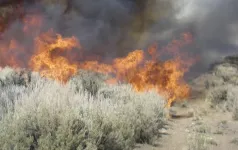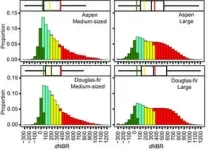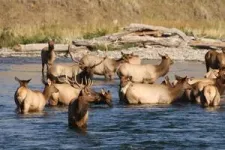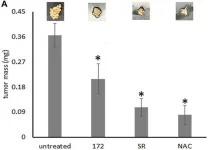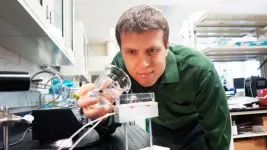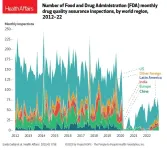(Press-News.org) For a century fire ecologists have worked to decipher a complex question — what does a “normal'' wildfire year look like in the West? That’s a hard question to answer for many reasons, but new research from a team in the Quinney College of Natural Resources shows that thanks to the state’s unique landscapes, Utah’s wildfire patterns may never fit into what is considered “normal” for other Western states.
Utah landscapes are diverse — from dense forests of pinyon-juniper to scattered patches of sagebrush and grasslands, Utah’s variable topography produces a tremendous range of wildfire behavior, said Jim Lutz, professor and author on the research. In some ways it defies easy characterization. Utah’s basin and range geography limits areas of connected vegetation and wildfire fuel, a big factor for minimizing the chance of megafires (so far) compared to other Western states, he said.
How a wildfire acts and the level of impact it has on a landscape depends in large part on the type of vegetation it moves through, how the vegetation and trees are connected across space, and the amount of built-up on-the-ground fuel left from the U.S.’s long policy of fire suppression. Although the state’s topography tends to produce comparatively smaller fires, that doesn’t mean Utah is out of the woods for impacts from future wildfires. Just because a fire isn’t big, doesn’t mean that it doesn’t have big impacts.
Lutz and Joseph Birch, from the Department of Wildland Resources, compiled and compared satellite data from the complete set of the hundreds of medium-sized (100-1,000 acres) and large (over 1,000 acres) wildfires in Utah between 1984 to 2022. They assessed each incident for burn severity in different types of vegetation. Typically the size of a fire is considered tied to its impact on the land — but this research found that medium-sized fires in Utah sometimes had a comparatively large impact.
On average, Utah wildfires tend to be heavily influenced by sagebrush and shrubland vegetation types — a category that covers a considerable area in the state. The medium-sized fires that the team analyzed in this type of non-forested vegetation had more severe impacts than large fires. In forests though, large fires burned at higher severity — sometimes much higher.
“Fires of any size can have considerable ecosystem benefits, including reducing the fuel loads that might later lead to extreme fire behavior, and reducing forest density. Both of these may become even more important in drought conditions,” said Lutz. “Prescribed fires that are as large as practically manageable can also provide these benefits.”
The authors suggest that deciding on a tractable size for prescribed burns, and predicting the characteristic results, could be aided by looking at the data on medium-sized fires in each vegetation type. Overall averages for burn severity of a given fire type, whether considered at the statewide level or for individual vegetation types, tend to be weighted to large fires, the researchers said.
“Fire activity from the recent past could help us understand what is going to happen in coming years, and serve as an informative baseline,” Lutz said, “but the long period of fire suppression we’ve had and increasing drought suggest that future fire may be more active than what we’ve seen in the past.”
END
Strange burn: new research identifies unique patterns in Utah wildfires
2023-12-04
ELSE PRESS RELEASES FROM THIS DATE:
New study identifies the greatest threat to wildlife across North America and Canada: people
2023-12-04
You see posts like these on neighborhood Facebook pages all the time: “An owl just flew into my window and appears stunned! Help!” or “I found a baby squirrel on the ground after the wind storm last night. Who do I call?” The answer is a local wildlife rehabilitation center—licensed individuals and organizations that take in hundreds of thousands of sick and injured wild animals nationwide each year. Wildlife rehabilitators see the highest number and greatest range of species of any government or nonprofit organization in the country, giving them unique insight into animal health—and making them great bellwethers of what’s ...
ORNL engineer Karen White honored with Lifetime Achievement Award
2023-12-04
Oak Ridge National Laboratory’s Karen White, who works in ORNL’s Neutron Science Directorate, has been honored with a Lifetime Achievement Award.
White, who manages the section that provides the machine controls,, computing infrastructure, and protection systems across all neutron science technical areas, received the award during the biennial International Conference on Accelerator and Large Experimental Physics Control Systems, held October 7-13, 2013, in Cape Town, South Africa. The award by ICALEPCS honors and celebrates an individual or individuals ...
Osteopontin induces mitochondrial biogenesis in deadherent cancer cells
2023-12-04
“Here, we study the induction of mitochondrial biogenesis by Osteopontin variants in deadherent breast tumor cells.”
BUFFALO, NY- December 4, 2023 – A new research paper was published in Oncotarget's Volume 14 on December 1, 2023, entitled, “Osteopontin induces mitochondrial biogenesis in deadherent cancer cells.”
Metastasizing cells display a unique metabolism, which is very different from the Warburg effect that arises in primary tumors. Over short time frames, oxidative phosphorylation and ATP generation are prominent. Over longer time frames, mitochondrial biogenesis becomes a pronounced ...
Boiled bubbles jump to carry more heat
2023-12-04
Water is often the go-to resource for heat transfer, being used in large-scale cooling operations like data centers that power the internet and nuclear power plants that power cities. Discovering dynamic phenomena to make water-based heat transfer more energy and cost efficient is the ongoing work of Jonathan Boreyko, associate professor and John R. Jones III Faculty Fellow in mechanical engineering.
Boreyko and his team have published extensively on the topic of water and the way it can move, with members of his Nature-Inspired ...
Increase in child suicide linked to the nation’s opioid crisis
2023-12-04
The rise in child suicides in the U.S. since 2010 was fueled in part by the nation’s opioid crisis, which previous studies found increased rates of child neglect and altered household living arrangements, according to a new RAND Corporation study.
The analysis links the rise is child suicides to the reformulation of prescription opioids to discourage misuse, which led to a steep rise in the use of illicit opioids such as heroin and may have contributed to the growth of illicit opioid markets.
Geographic areas that were more exposed to ...
UCLA scientists receive $9.1 million from the NCI to improve early detection methods for cancer
2023-12-04
Researchers from the UCLA Health Jonsson Comprehensive Cancer Center have received two grants totaling $9.1 million from the National Cancer Institute to advance liquid biopsy technologies for the early detection of cancer, which can significantly improve treatment outcomes and reduce the number of deaths caused by the disease.
A liquid biopsy is a promising non-invasive medical test using a small volume of blood that gives scientists insight into the genetic makeup of tumors. By analyzing these components, researchers can gain valuable information about the genetic mutations, alterations and other molecular changes associated ...
Health Affairs’ December Issue: Global Lessons From COVID-19
2023-12-04
Washington D.C.—The December Health Affairs, a theme issue about the lessons learned around the globe from the COVID-19 pandemic, covers topics including how modeling was used to respond to the pandemic, how health inequities emerged and were addressed, and how countries tried to protect their vulnerable residents. The December issue of Health Affairs was supported by the Robert Wood Johnson Foundation and the Merck Foundation.
There will be a Health Affairs briefing on Tuesday, December 5, from 11:00 a.m. to 2:00 p.m. ET. Register here.
COVID-19, a decline in FDA foreign facility inspections.
At the start of the COVID-19 pandemic, the Food and Drug Administration (FDA) halted ...
BioOne announces Subscribe to Open Pilot
2023-12-04
WASHINGTON D.C. – BioOne, the leading nonprofit aggregator in the biological, ecological, and environmental sciences, today announces a bold plan to offer up to 80 society titles as part of a Subscribe to Open (S2O) pilot beginning in January 2026.
This decision, unanimously endorsed by the BioOne Board of Directors, follows 18 months of careful feasibility analysis and extensive interviews with BioOne’s community of society and library partners in search of an equitable and sustainable path to open.
BioOne will work with its publishing community throughout 2024 to encourage participation in the pilot, ...
Unveiling a new era of imaging: Boston University engineers lead breakthrough microscopy techniques
2023-12-04
When microscopes struggle to pick up faint signals, it’s like trying to spot subtle details in a painting or photograph without your glasses. For researchers, this makes it difficult to catch the small things happening in cells or other materials. In new research, Boston University Moustakas Chair Professor in Photonics and Optoelectronics, Dr. Ji-Xin Cheng and collaborators are creating more advanced techniques to make microscopes better at seeing tiny sample details, without needing special dyes. Their results, published in Nature Communications and Science Advances respectively, are helping scientists visualize and understand their samples in an easier ...
New wearable communication system offers potential to reduce digital health divide
2023-12-04
Wearable devices that use sensors to monitor biological signals can play an important role in health care. These devices provide valuable information that allows providers to predict, diagnose and treat a variety of conditions while improving access to care and reducing costs.
However, wearables currently require significant infrastructure – such as satellites or arrays of antennas that use cell signals – to transmit data, making many of those devices inaccessible to rural and under-resourced communities.
A group of University of Arizona researchers has set out to change that with a wearable monitoring device system that can send ...
